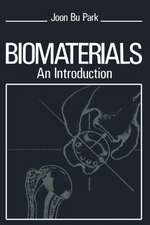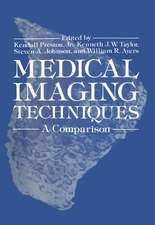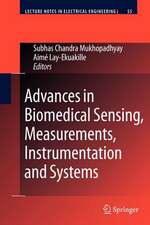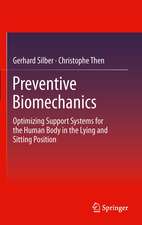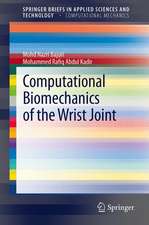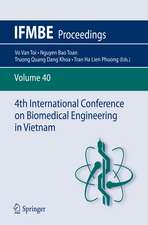Anthropometry and Biomechanics: Theory and Application: Nato Conference Series, cartea 16
Editat de Ronald Easterbyen Limba Engleză Paperback – 18 feb 2012
Din seria Nato Conference Series
- 5%
 Preț: 389.56 lei
Preț: 389.56 lei - 15%
 Preț: 705.99 lei
Preț: 705.99 lei - 15%
 Preț: 661.32 lei
Preț: 661.32 lei -
 Preț: 389.49 lei
Preț: 389.49 lei -
 Preț: 412.95 lei
Preț: 412.95 lei - 18%
 Preț: 1241.42 lei
Preț: 1241.42 lei -
 Preț: 389.70 lei
Preț: 389.70 lei -
 Preț: 409.69 lei
Preț: 409.69 lei - 20%
 Preț: 585.72 lei
Preț: 585.72 lei -
 Preț: 412.57 lei
Preț: 412.57 lei -
 Preț: 396.78 lei
Preț: 396.78 lei -
 Preț: 399.12 lei
Preț: 399.12 lei -
 Preț: 415.29 lei
Preț: 415.29 lei -
 Preț: 397.97 lei
Preț: 397.97 lei -
 Preț: 396.62 lei
Preț: 396.62 lei -
 Preț: 390.08 lei
Preț: 390.08 lei - 5%
 Preț: 378.07 lei
Preț: 378.07 lei - 18%
 Preț: 1235.57 lei
Preț: 1235.57 lei - 15%
 Preț: 495.26 lei
Preț: 495.26 lei -
 Preț: 392.37 lei
Preț: 392.37 lei -
 Preț: 413.15 lei
Preț: 413.15 lei -
 Preț: 404.67 lei
Preț: 404.67 lei -
 Preț: 396.40 lei
Preț: 396.40 lei - 15%
 Preț: 662.16 lei
Preț: 662.16 lei - 15%
 Preț: 666.41 lei
Preț: 666.41 lei -
 Preț: 382.75 lei
Preț: 382.75 lei - 18%
 Preț: 822.01 lei
Preț: 822.01 lei -
 Preț: 401.57 lei
Preț: 401.57 lei -
 Preț: 403.91 lei
Preț: 403.91 lei -
 Preț: 404.67 lei
Preț: 404.67 lei -
 Preț: 403.15 lei
Preț: 403.15 lei -
 Preț: 411.42 lei
Preț: 411.42 lei -
 Preț: 440.71 lei
Preț: 440.71 lei -
 Preț: 408.63 lei
Preț: 408.63 lei - 15%
 Preț: 647.27 lei
Preț: 647.27 lei -
 Preț: 393.74 lei
Preț: 393.74 lei -
 Preț: 392.97 lei
Preț: 392.97 lei - 18%
 Preț: 1234.62 lei
Preț: 1234.62 lei -
 Preț: 412.95 lei
Preț: 412.95 lei -
 Preț: 390.46 lei
Preț: 390.46 lei -
 Preț: 405.66 lei
Preț: 405.66 lei - 15%
 Preț: 667.54 lei
Preț: 667.54 lei - 18%
 Preț: 1242.03 lei
Preț: 1242.03 lei - 18%
 Preț: 1225.62 lei
Preț: 1225.62 lei - 15%
 Preț: 679.00 lei
Preț: 679.00 lei -
 Preț: 401.03 lei
Preț: 401.03 lei -
 Preț: 399.12 lei
Preț: 399.12 lei -
 Preț: 413.15 lei
Preț: 413.15 lei
Preț: 722.69 lei
Preț vechi: 760.73 lei
-5% Nou
Puncte Express: 1084
Preț estimativ în valută:
138.28€ • 144.38$ • 114.45£
138.28€ • 144.38$ • 114.45£
Carte tipărită la comandă
Livrare economică 04-18 aprilie
Preluare comenzi: 021 569.72.76
Specificații
ISBN-13: 9781468411003
ISBN-10: 1468411004
Pagini: 340
Ilustrații: X, 328 p.
Dimensiuni: 178 x 254 x 18 mm
Greutate: 0.59 kg
Ediția:Softcover reprint of the original 1st ed. 1982
Editura: Springer Us
Colecția Springer
Seriile Nato Conference Series, III Human Factors
Locul publicării:New York, NY, United States
ISBN-10: 1468411004
Pagini: 340
Ilustrații: X, 328 p.
Dimensiuni: 178 x 254 x 18 mm
Greutate: 0.59 kg
Ediția:Softcover reprint of the original 1st ed. 1982
Editura: Springer Us
Colecția Springer
Seriile Nato Conference Series, III Human Factors
Locul publicării:New York, NY, United States
Public țintă
ResearchCuprins
Opening Address.- Postural Research — The Next Challenge to Anthropometrics and Biomechanics.- Session I: Data Acquisition Methods.- Fundamentals of Anthropometric Survey Measurement Techniques.- Evolution of the Techniques of Data Collecting and Processing in Biometry.- Results of Large-Scale Anthropometrie Surveys.- The Human Machine in Three Dimensions: Implications for Measurement and Analysis.- An Anthropometric Data Bank: Its Hidden Dimensions.- Session II: Anthropometric Data Bases.- Present and Future Needs for Anthropometric Data Bases.- Anthropometric and Biomechanical Data Acquisition and Application to Rehabilitation Engineering.- Anthropometry of Mentally and Physically Handicapped Persons Employed in Productive Occupations.- Progress and Prospects in Human Biometry; Evolution of the Measurement Techniques and Data Handling Methods.- Session III: Models of Anthropometric Data.- Biomechanical Computer Modeling for the Design and Evaluation of Work Stations.- User Needs in Computerised Man Models.- Some Computational Problems in Developing Computerized Man-Models.- Empirical Models of Individuals and Population Maximum Reach Capability.- Issues in the Statistical Modeling of Anthropometric Data for Workplace Design.- Session IV: Maximum Voluntary Exertion Data.- Overview of Methods to Assess Voluntary Exertions.- Postural Considerations in Maximum Voluntary Exertion.- Standardized Strength Testing Methods for Population Descriptions.- Evaluation of Controlled Static Exertions in Various Muscle Groups.- On-Site Maximum Voluntary Exertion Measurements and Job Evaluation.- Session V: Models of Biomechanical Data.- New Perspectives and Needs in Biomechanical Modelling.- The Development and Use of Biomechanical Strength Models.- The Validity of BiomechanicalModels of Volitional Activities.- Development of a Biomechanical Hand Model for Study of Manual Activities.- Factor Analytic Approach to Biomechanical Modeling.- Session VI: Applications I.- Workspace Evaluation and Design: USAF Drawing Board Manikins and the Development of Cockpit Geometry Design Guides.- Somatography in Workspace Design.- A Systems Approach to Long Term Task Seating Design.- Evaluation of Chairs Used by Air Traffic Controllers of the U.S. Federal Aviation Administration-Implications for Design.- Biomechanical and Engineering Anthropometry Considerations for the Assessment of Amputees’ Work Performance.- Session VII: Applications II.- Anthropometric and Strength Data in Tool Design.- Container and Handle Design for Manual Handling.- Application of Dynamic Testing and Anthropometic Computer Modeling in Design of an Aircraft/ Ejection Escape System.- The Collection and Application of Anthropometric Data for Domestic and Industrial Standards.- Computer Aided Crew Station Design for the NASA Space Shuttle.- Session VIII: Future Needs and Perspectives.- Postural Considerations in Workspace Design.- Anthropometric and Biomechanical Considerations in Government Regulations.- Extending the State of the Art in Anthropometry and Biomechanics.







